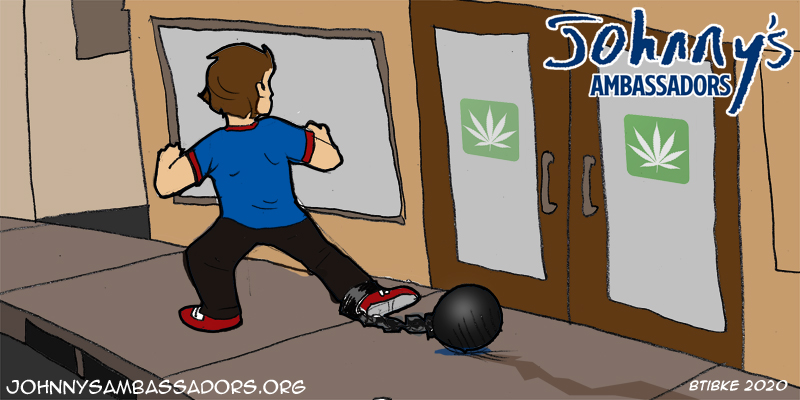By Laura Stack
Let’s be blunt, shall we? In the short term, marijuana doesn’t have the overdose potential of heroin and cocaine. Clearly, hard narcotics are very dangerous to your health, with readily visible outcomes. Marijuana seems tame by comparison—in the short term, anyway. That’s why it’s so dangerous—its relative mildness makes it more insidious than harder drugs. However, today’s high-THC products are narcotic strength, with risky long-term mental consequences.
Teens like to use the classic lame excuse to justify themselves, “It’s just pot, not crack.” True, teens may get paranoid, depressed, or delusional; however, they rarely drop dead from using too much. But now they’ve hooked up with a sly chemical beast that short-circuits the reward neurons in the brain, something common to all addictive substances. In many cases, they don’t see the downsides until early adulthood. Like Johnny, they continue to use, and mental illness manifests many years later.
Those who start using marijuana in adolescence suffer the most severe psychological effects. In part, this happens because the chemicals in marijuana called cannabinoids block the receptors of important neurotransmitters in brain cells called endocannabinoids, which play an important role in brain development. Since brain development doesn’t finish until the mid-20s, young users unknowingly stunt their own mental growth.
If It Has an SUD, It’s a Drug
All drugs have associated Substance Use Disorders, as defined in psychiatric circles. Cannabis Use Disorder, or CUD (and sometimes MUD, for Marijuana Use Disorder) lies near the top of the list of the most common SUDs. Despite some claims in the pro-pot literature painting CUD/MUD as harmless or beneficial to the user, it’s just as difficult to shake as any SUD, with the same withdrawal symptoms—including cravings, anger, aggression, irritability, nervousness, restlessness, anxiety, insomnia, depression, nightmares, weight loss, lack of appetite, abdominal pain, tremors, fevers, chills, constant sweating, and headaches.
You can definitely count CUD as another downside of marijuana use, though it’s much more common than most of the ailments listed above. Add it into the mix, and after a while, the pain inflicted by marijuana exceeds any pleasure it offers. But by the time a user has CUD, its hooks are in them so deep, it’s hard to escape without a lot of help.
The Statistics
Marijuana has a low popular perception of danger, among both adults and youths. This is due to a false narrative by media and the pot industry and our governments to an extent, since marijuana is legal, it can’t be bad for you, right? Marketing targets our youth, because the industry needs its next generation of addicts to be profitable. 20% of users account for 80% of sales, and the greatest age of use is 18-25. Literally tens of millions of Americans use it, many daily, especially since its legalization across many of the United States. It can be a relatively inexpensive high, depending on the form ingested. Some users believe it has soothing or medicinal effects in its popular herb, tincture, and edible forms, though standard, less expensive medications work better than marijuana.
Before the formal definition of SUDs in the last decade or so, mental health professionals considered all aspects of what they now call CUD as addiction. Today, they divide users into low, moderate, and severe dependence categories. The difference between cannabis dependence and cannabis addiction is one of degree rather than kind, with the presence of six or more of the 11 diagnostic symptoms for SUDs laid out in the American Psychiatric Association’s Diagnostic and Statistical Manual of Mental Disorders, Fifth Edition defining high dependence—i.e., deep addiction.
According to commonly quoted numbers, about 9% of cannabis users suffer from addiction, with another 30% being cannabis dependent. A new study, however, has revised those numbers upward. This one is a meta-study; i.e., it analyzes the results of many previous studies, and draws its conclusions from their collective results. Researchers Janni Leung, Gary C.K. Chan, Leanne Hides, and Wayne D. Hall examined the results of 21 previous studies in the course of their work. Their conclusions are admittedly a bit difficult to parse, since they reported the results of CUD, cannabis addiction, and cannabis dependence separately, whereas most authorities consider addiction and dependence aspects of CUD in general.
Even reported separately, the results are eye-opening. The researchers concluded that 22% of regular users suffer from CUD, while 13% have a cannabis dependence, and 13% suffer from cannabis addiction. If we fold dependence and addiction into CUD (as most researchers do), this suggests half of regular marijuana users have some form of CUD. The deep addiction rate also stands significantly higher than previously reported. Furthermore, this meta-study reveals that the younger a user starts using, the more likely cannabis dependence will occur; the rate rises to an average of 33%. Hence, the younger someone starts and the more marijuana they use, the higher the risks. Once again, science confirms common sense.
MUD On Your Face, a Big Disgrace
Marijuana Use Disorder is a Substance Use Disorder just like any other. Once it forms, it’s no less dangerous or painful than any other SUD. It’s the standard monkey-on-your-back that most pot users initially think only “real” junkies have—because, after all, it’s only grass, right?
Tobacco and liquor are also legal, and we’ve all seen the downsides of both. Frequent use of alcohol, tobacco, or pot isn’t harmless or glamorous, no matter what the sellers of those substances might suggest. All three substances are legal, but all three can nonetheless give you a nasty SUD. And let’s be real. Those afflicted with any SUD are like Marley’s ghost, wrapped in chains of their own making. To those of us watching from outside and hearing the names of the marijuana SUD, the mental image is a less than impressive—whether you think of the user as chewing a CUD, or with mouthful of MUD.
Let’s hope we see the light quickly, before we lose many generations of young people to mental illness and suicide.


